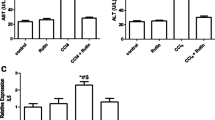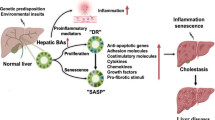Abstract
Xanthinoxidase (XO) derived radical species are involved in bacterial translocation (BT) in cholestatic rats. The mechanism by which XO influences remains unclear. It has been shown recently that nuclear factor-kappa B (NF-κB), a ubiquitous transcription factor, can be activated by oxidative stress and thereby promote the process of BT. We investigated the effects of NF-κB inactivation on the incidence of BT in cholestatic rats. Sprague-Dawley rats were randomly assigned to one of eight groups: groups 1–4 were sham laparotomized rats either untreated (S1) or treated for 5 days with thalidomide (S2), curcumin (S3), or Inchin-ko (ICK; S4); groups 5–8 underwent common bile duct ligation (CBDL) for 5 days and were either untreated (C1) or treated with thalidomide (C2), curcumin (C3), or ICK (C4). After 5 days bacteriological cultures were performed from portal blood and V. cava, from the central mesenteric lymph node complex (MLN), spleen, and liver. The intensity of the activated NF-κB-subunit p65/p50 in the ileum mucosa was estimated by light microscopy and a scoring system from 1 to 20. Malondialdehyde (MDA) and myeloperoxidase activity (MPO) in the ileum were evaluated and expressed as U/g dry weight. Thalidomide and ICK reduced in CBDL-rats significantly the BT rate (63% vs. 18%, 63% vs. 30%, P<0.01). Enzyme estimations (MDA, MPO, and GSH) in sham operated animals showed no significant changes in the untreated groups compared with the treated groups. CBDL-rats pre-treatment with all three compounds caused a significant increase of MDA levels if groups were compared with the untreated C1-group (C1 31.6±7.7, C2 54.5±12.2, C3 53.3±11.2, and C4 47.2±9.4). GSH was reduced after the pre-treatment by all compounds but only significantly after curcumin pre-treatment (C1 vs. C3: 13.9±1.8 vs. 7.1±1.8; P<0.05). MPO estimations were significantly higher in the untreated C1-group if compared with groups C2, C3, and C4 (C1 1036.4±340.9, C2 709.9±125.9, C3 545.2±136.6, and C4 556.7±247.4; P<0.05). Thalidomide inhibited significantly the activation of NF-κB (C2 vs. C1: 6.0±4.5 vs. 12.7±5.3; P<0.01). Likewise, Curcumin and ICK suppressed NF-κB activation, but this did not reach significance in this experiment. NF-κB is involved in the process of BT in cholestatic rats and may be activated by XO derived ROS. We assume that the activated NF-κB initiates transcription of target genes inducing cytokine production, which in turn disrupts the tight junctions leading to BT from the intestinal lumen to the MLNs and circulation.




Similar content being viewed by others
References
Gilgert JA, Kamath PS (1995) Spontaneous bacterial peritonitis: an update. Mayo Clin Proc 70:365–370
Mihas AA, Toussaint J, Hsue HS, Dotherow P, Achord JL (1992) Spontaneous bacterial peritonitis in cirrhosis: clinical and laboratory feature, survival and prognostic indicators. Hepato-gastroenterology 39:520–522
Schimpl G, Pesendorfer P, Steinwender G, Feierl G, Ratschek M, Höllwarth ME (1996) Allopurinol and glutamine attenuate bacterial translocation in chronic portal hypertensive and common bile duct ligated growing rats. Gut 39(1):48–53
Schimpl G, Pesendorfer P, Steinwender G, Feierl G, Ratschek M, Höllwarth ME (1996) Allopurinol reduces bacterial translocation, intestinal mucosal lipid peroxidation, and neutrophil-derived myeloperoxidase activity in chronic portal hypertensive and common bile duct-ligated growing rats. Pediatr Res 40(3):422–428
Schimpl G, Pesendorfer P, Steinwender G, Feierl G, Ratschek M, Höllwarth ME (1997) The effect of vitamin C and vitamin E supplementation on bacterial translocation in chronic portal hypertensive and common-bile-duct-ligated rats. Eur Surg Res 29:187–194
Schimpl G, Pabst MA, Feierl G, Kuesz A, Ozbey H, Takahashi S, Höllwarth ME (1999) A tungsten supplemented diet attenuates bacterial translocation in chronic portal hypertensive and cholestatic rats: role of xanthine dehydrogenase and xanthine oxidase. Gut 45(6):904–910
Irani K (2000) Oxidant signaling in vascular cell growth, death, and survival: a review of the roles of reactive oxygen species in smooth muscle and endothelial cell mitogenic and apoptotic signaling. Circ Res 87(3):179–183
Suzuki YJ, Forman HJ, Sevanian A (1997) Oxidants as stimulators of signal transduction. Free Radic Biol Med 22(1–2):269–285
Schmidt KN, Amstad P, Cerutti P, Baeuerle PA (1995) The roles of hydrogen peroxide and superoxide as messengers in the activation of transcription factor NF-kappa B. Chem Biol 2(1):13–22
Hancock JT, Desikan R, Neill SJ (2001) Role of reactive oxygen species in cell signalling pathways. Biochem Soc Trans 29:345–350
Schreck R, Albermann K, Baeuerle PA (1992) Nuclear factor kappa B: an oxidative stress-responsive transcription factor of eukaryotic cells (a review). Free Radic Res Commun 17(4):221–237
Baeuerle PA, Henkel T (1994) Function and activation of NF-kappa B in the immune system. Annu Rev Immunol 12:141–179
Majumdar S, Lamothe B, Aggarwal BB (2002) Thalidomide suppresses NF-kappa B activation induced by TNF and H2O2, but not that activated by ceramide, lipopolysaccharides, or phorbol ester. J Immunol 168(6):2644–2651
Neurath MF, Fuss I, Kelsall B, Meyer zum Buschenfelde KH, Strober W (1996) Effect of IL-12 and antibodies to IL-12 on established granulomatous colitis in mice. Ann NY Acad Sci 795:368–370
Shishodia S, Amin HM, Lai R, Aggarwal BB (2005) Curcumin (diferuloylmethane) inhibits constitutive NF-kappaB activation, induces G1/S arrest, suppresses proliferation, and induces apoptosis in mantle cell lymphoma. Biochem Pharmacol 70(5):700–713
Kim GY, Kim KH, Lee SH, Yoon MS, Lee HJ, Moon DO, Lee CM, Ahn SC, Park YC, Park YM (2005) Curcumin inhibits immunostimulatory function of dendritic cells: MAPKs and translocation of NF-kappa B as potential targets. J Immunol 174(12):8116–8124
Kobayashi H, Horikoshi K, Yamataka A, Lane GJ, Yamamoto M, Miyano T (2001) Beneficial effect of a traditional herbal medicine (inchin-ko-to) in postoperative biliary atresia patients. Pediatr Surg Int 17:386–389
Schimpl G, Feierl G, Linni K, Uitz C, Ozbey H, Höllwarth ME (1999) Bacterial translocation in short-bowel syndrome in rats. Eur J Pediatr Surg 9:224–227
Wong SH, Knight JA, Hopfer SM, Zaharia O, Leach CN Jr, Sunderman FW Jr (1987) Lipid peroxides in plasma as measured by liquid-chromatographic separation of malondialdehyde-thiobarbituric acid adduct. Clin Chem 33:214–222
Nakagawa K (1991) Decreased glutathione S-transferase activity in mice livers by acute treatment with lead, independent of alteration in glutathione content. Toxicol Lett 56:13–17
Krawisz JE, Sharon P, Stenson WF (1984) Quantitative assay for acute intestinal inflammation based on myeloperoxidase activity: assessment of inflammation in rat and hamster models. Gastroenterology 87:1344–1350
Magnotti LJ, Deitch EA (2005) Burns, bacterial translocation, gut barrier function, and failure. J Burn Care Rehabil 26(5):383–391
Madl C, Druml W (2003) Gastrointestinal disorders of the critically ill. Systemic consequences of ileus. Best Pract Res Clin Gastroenterol 17(3):445–456
Luyer MD, Buurman WA, Hadfoune M, Jacobs JA, Konstantinov SR, Dejong CH, Greve JW (2004) Pretreatment with high-fat enteral nutrition reduces endotoxin and tumor necrosis factor-alpha and preserves gut barrier function early after hemorrhagic shock. Shock 21(1):65–71
Wildhaber BE, Yang H, Spencer AU, Drongowski RA, Teitelbaum DH (2005) Lack of enteral nutrition—effects on the intestinal immune system. J Surg Res 123(1):8–16
Piena M, Albers MJ, Van Haard PM, Gischler S, Tibboel D (1998) Introduction of enteral feeding in neonates on extracorporeal membrane oxygenation after evaluation of intestinal permeability changes. J Pediatr Surg 33(1):30–34
Deitch EA, Sittig K, Li M, Berg R, Specian RD (1990) Obstructive jaundice promotes bacterial translocation from the gut. Am J Surg 159(1):79–84
Ding JW, Andersson R, Soltesz V, Willen R, Bengmark S (1993) The role of bile and bile acids in bacterial translocation in obstructive jaundice in rats. Eur Surg Res 25(1):11–19
Slocum MM, Sittig KM, Specian RD, Deitch EA (1992) Absence of intestinal bile promotes bacterial translocation. Am Surg 58(5):305–310
Albanese CT, Cardona M, Smith SD, Watkins S, Kurkchubasche AG, Ulman I, Simmons RL, Rowe MI (1994) Role of intestinal mucus in transepithelial passage of bacteria across the intact ileum in vitro. Surgery 116(1):76–82
Albanese CT, Smith SD, Watkins S, Kurkchubasche A, Simmons RL, Rowe MI (1994) Effect of secretory IgA on transepithelial passage of bacteria across the intact ileum in vitro. J Am Coll Surg 179(6):679–688
Mattar AF, Teitelbaum DH, Drongowski RA, Yongyi F, Harmon CM, Coran AG (2002) Probiotics up-regulate MUC-2 mucin gene expression in a Caco-2 cell-culture model. Pediatr Surg Int 18(7):586–590
Schreck R, Rieber P, Baeuerle PA (1991) Reactive oxygen intermediates as apparently widely used messengers in the activation of the NF-kappa B transcription factor and HIV-1. EMBO J 10(8):2247–2258
Schieven GL, Kirihara JM, Myers DE, Ledbetter JA, Uckun FM (1993) Reactive oxygen intermediates activate NF-kappa B in a tyrosine kinase-dependent mechanism and in combination with vanadate activate the p56lck and p59fyn tyrosine kinases in human lymphocytes. Blood 82(4):1212–1220
Anderson MT, Staal FJ, Gitler C, Herzenberg LA, Herzenberg LA (1994) Separation of oxidant-initiated and redox-regulated steps in the NF-kappa B signal transduction pathway. Proc Natl Acad Sci USA 91(24):11527–11531
Schmidt KN, Amstad P, Cerutti P, Baeuerle PA (1995) The roles of hydrogen peroxide and superoxide as messengers in the activation of transcription factor NF-kappa B. Chem Biol 2(1):13–22
Brennan P, O’Neill LA (1995) Effects of oxidants and antioxidants on nuclear factor kappa B activation in three different cell lines: evidence against a universal hypothesis involving oxygen radicals. Biochim Biophys Acta 1260(2):167–175
Baeuerle PA, Henkel T (1994) Function and activation of NF-kappa B in the immune system. Annu Rev Immunol 12:141–179
Baeuerle PA (1991) The inducible transcription activator NF-kappa B: regulation by distinct protein subunits. Biochim Biophys Acta 1072(1):63–80
Rouquette M, Page S, Bryant R, Benboubetra M, Stevens CR, Blake DR, Whish WD, Harrison R, Tosh D (1998) Xanthine oxidoreductase is asymmetrically localised on the outer surface of human endothelial and epithelial cells in culture. FEBS Lett 426(3):397–401
Acknowledgements
We are indebted to A.M. Kuesz for performing the immunohistochemical-assays.
Author information
Authors and Affiliations
Corresponding author
Rights and permissions
About this article
Cite this article
Weber-Mzell, D., Zaupa, P., Petnehazy, T. et al. The role of nuclear factor-kappa B in bacterial translocation in cholestatic rats. Ped Surgery Int 22, 43–49 (2006). https://doi.org/10.1007/s00383-005-1599-y
Published:
Issue Date:
DOI: https://doi.org/10.1007/s00383-005-1599-y




